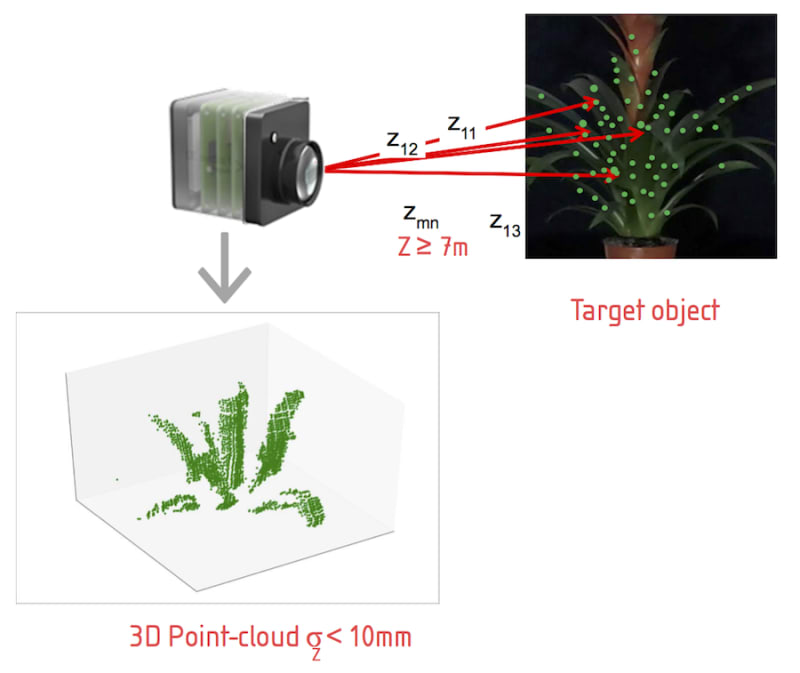Low cost 3D ToF CMOS technology allows mass-production solid-states Lidars to
provide fast-motion sensing based on 3D imaging for Automotive Driving Assistance (ADAS) and autonomous vehicle.
About 1.25 million people die each year as a result of road traffic crashes.
Road traffic injuries are the leading cause of death among young people, aged 15–29 years. Therefore, ADAS and autonomous vehicle is becoming a big hype as it will save a lot of lives each year.
The technology relies on the measurement of the time of arrival of reflected illumination from infra-red lasers (direct time-of-flight or ToF) detected by single photonavalanche diodes (SPAD). This provides :
- Resolution ( >1.5 mm, 10ps time of single-photon detector – operational resolution >2cm).
- Accuracy (operations under bright or dark lighting condition, high signal/noise ratio; interference de-correlation leveraging high frequency pulsed illumination).
- Medium Range (>50m, VCSEL arrays or laser with >1W peak power and eye-safe short pulses).
- Speed (>300-1000 fps, low blurring of 20m/s motion, no analog light intensity integration).
- Low Cost (standard digital CMOS circuits, consumer electronics and smartphones prices, low power).
Novel Idea: Sensor-arrays based on Single Photon Avalanche Diode (SPAD) on standard CMOS process was never done before mass-production oriented. Furthermore, today the LIDAR technology used in automotive industry is mainly laser-scanners which are too much expensive (more than 1'000 USD) to be produced at high-volume. Also, automotive industry does not feel confident with mechanical moving parts as it is in laser-scanners.
The market focus is automotive (ADAS) and Industry Machine Vision (autonomous robots, service robots, industrial robots, drones, security like people counting, movement detection) despite the fact that the technology is suitable for consumers application as well: 3D autofocus for smartphones, eye-tracking, gesture recognition, etc.
ADDRESSABLE MARKET: US$100M MARKET FOR 3D TOF CAMERA MODULES FOR AUTOMOTIVE AND ROBOTICS >25% CAGR
Automotive driving assistance vision:
Addressable 3D ToF market will grow from US$10M to US$1B in 2020. US$500M market for automotive cameras growing 28%, (ADAS is mandated by NCAP EuroNCAP industry ratings).
Tier I/II Integrators: Autoliv, Bosch, Continental, Denso, Delphi, IEE, Magneti-Marelli, Mando Corp., ZF-TRW, Valeo, Visteon, Siemens, and NEC
Machine and vision guided robotics:
Addressable 3D ToF market will grow from US$50M to US$300M by 2020. US$5.6 B market for machine vision cameras, >15% based on 3D imaging, growing 15%.
Target integrators: Cognex, Sick, IFM electronics, P+F, Baumer, Keyence, Balluff, Leuze Electronics.
3D Time-OF-Flight is simple: we send a laser-flash and then we measure the time it takes to hit an obstacle and come back to our sensor. Then you can calculate the distance between the camera and the obstacle, recognize the shape of the obstacle and define the action to be taken (for a car, avoid the obstacle).
As the technology is standard CMOS semiconductor, the production is outsourced in one of the worlwide semiconductor industry (NXP, TSMC, or other).
Compare to a laser-scanner Lidar, the solid-state ToF technology is 10 times less expensive: 500 USD instead of 5'000 USD
Video
Like this entry?
-
About the Entrant
- Name:Cécile Vienney
- Type of entry:individual
- Patent status:patented








